Business and the Business Environment Report
VerifiedAdded on 2020/02/03
|7
|1806
|125
Report
AI Summary
This report analyzes Tesco's business environment, focusing on the macro and micro factors influencing its operations. It begins with an introduction to Tesco and its business environment, followed by a detailed examination of the positive and negative impacts of the macro environment using the PESTLE model. The report then delves into an internal and external analysis of Tesco, identifying its strengths and weaknesses in relation to macro factors. A SWOT analysis is conducted to assess Tesco's competitive position. Finally, the report distinguishes between macro and micro factors and concludes by summarizing the key findings and their implications for Tesco's strategic decision-making. The report utilizes various academic sources to support its analysis and provides a comprehensive overview of Tesco's business environment.
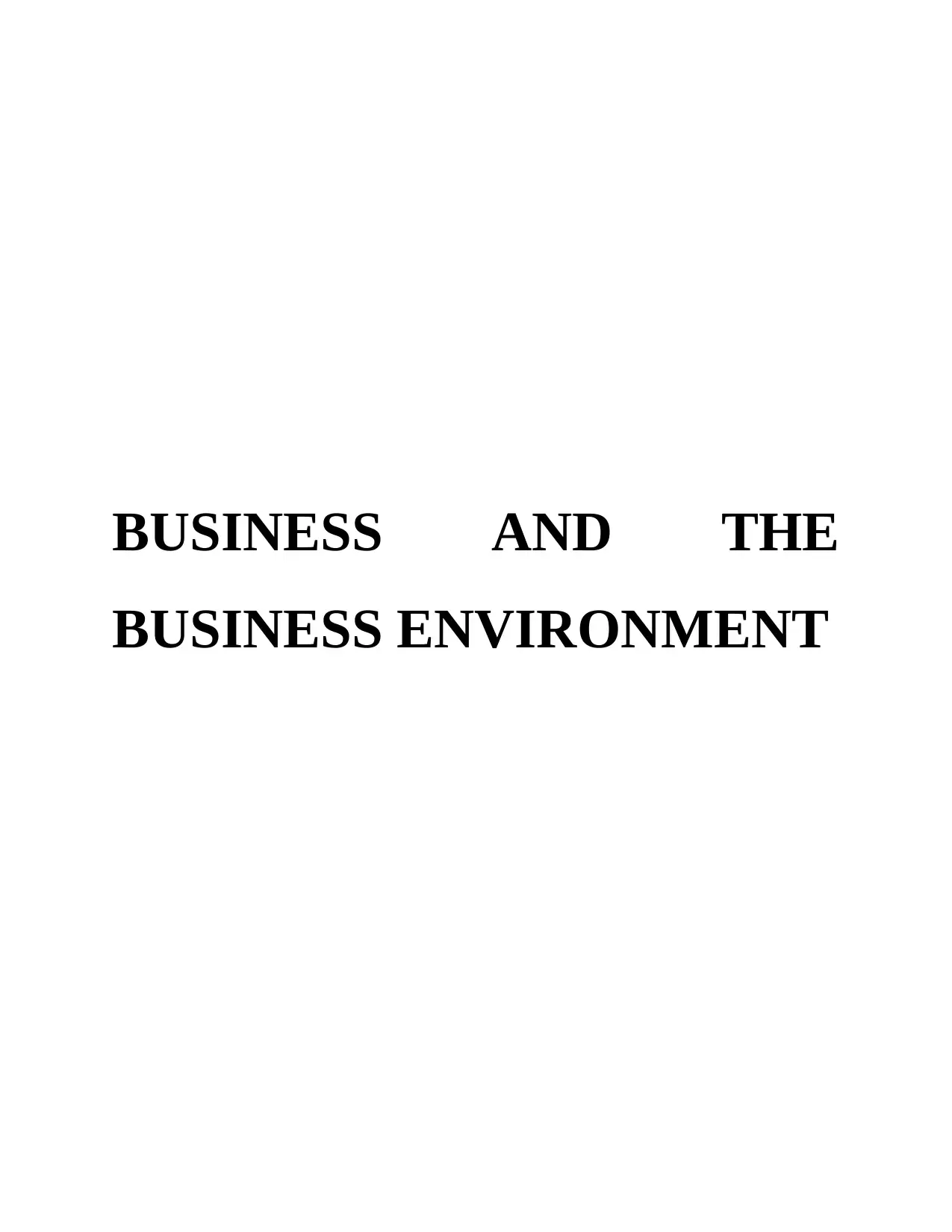
BUSINESS AND THE
BUSINESS ENVIRONMENT
BUSINESS ENVIRONMENT
Paraphrase This Document
Need a fresh take? Get an instant paraphrase of this document with our AI Paraphraser
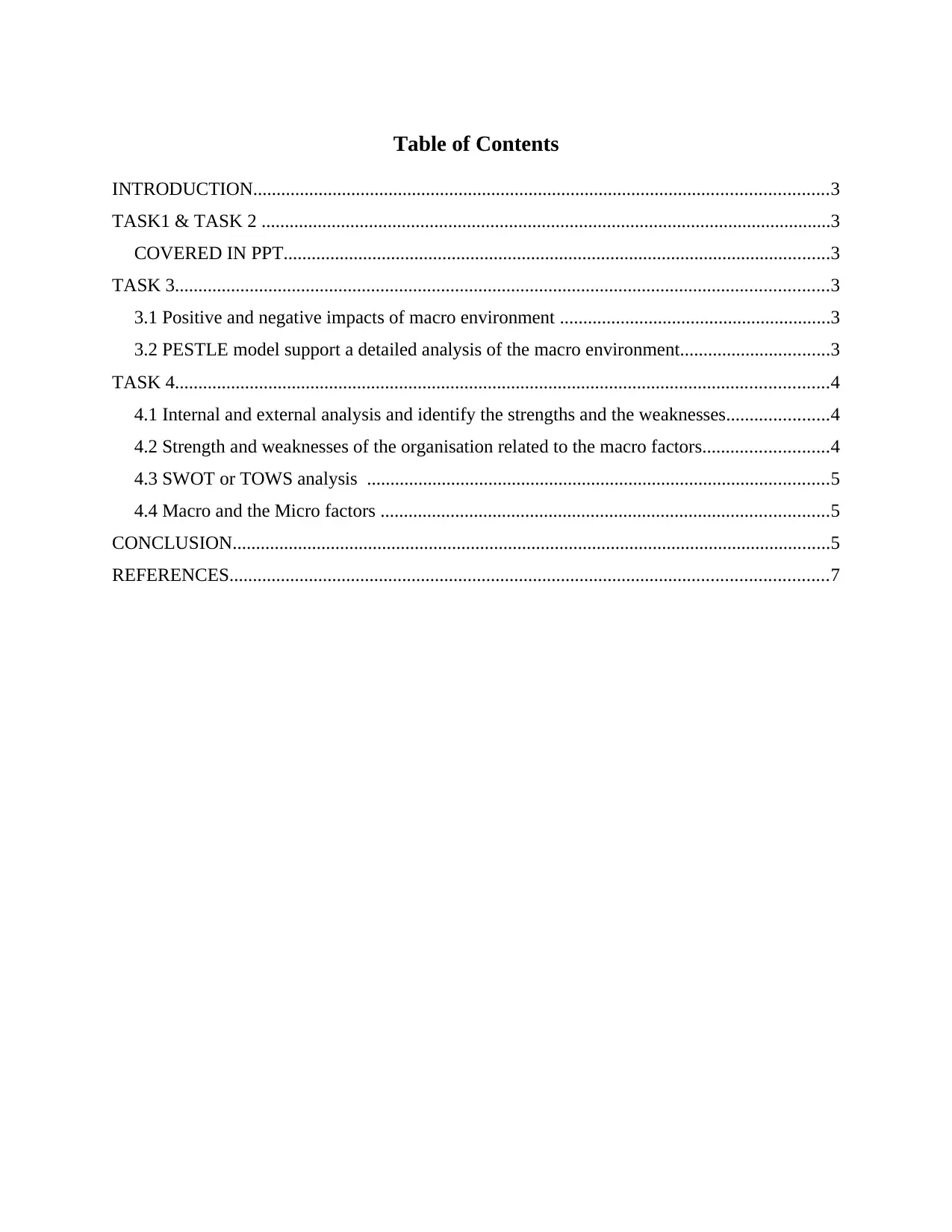
Table of Contents
INTRODUCTION...........................................................................................................................3
TASK1 & TASK 2 ..........................................................................................................................3
COVERED IN PPT.....................................................................................................................3
TASK 3............................................................................................................................................3
3.1 Positive and negative impacts of macro environment ..........................................................3
3.2 PESTLE model support a detailed analysis of the macro environment................................3
TASK 4............................................................................................................................................4
4.1 Internal and external analysis and identify the strengths and the weaknesses......................4
4.2 Strength and weaknesses of the organisation related to the macro factors...........................4
4.3 SWOT or TOWS analysis ...................................................................................................5
4.4 Macro and the Micro factors ................................................................................................5
CONCLUSION................................................................................................................................5
REFERENCES................................................................................................................................7
INTRODUCTION...........................................................................................................................3
TASK1 & TASK 2 ..........................................................................................................................3
COVERED IN PPT.....................................................................................................................3
TASK 3............................................................................................................................................3
3.1 Positive and negative impacts of macro environment ..........................................................3
3.2 PESTLE model support a detailed analysis of the macro environment................................3
TASK 4............................................................................................................................................4
4.1 Internal and external analysis and identify the strengths and the weaknesses......................4
4.2 Strength and weaknesses of the organisation related to the macro factors...........................4
4.3 SWOT or TOWS analysis ...................................................................................................5
4.4 Macro and the Micro factors ................................................................................................5
CONCLUSION................................................................................................................................5
REFERENCES................................................................................................................................7
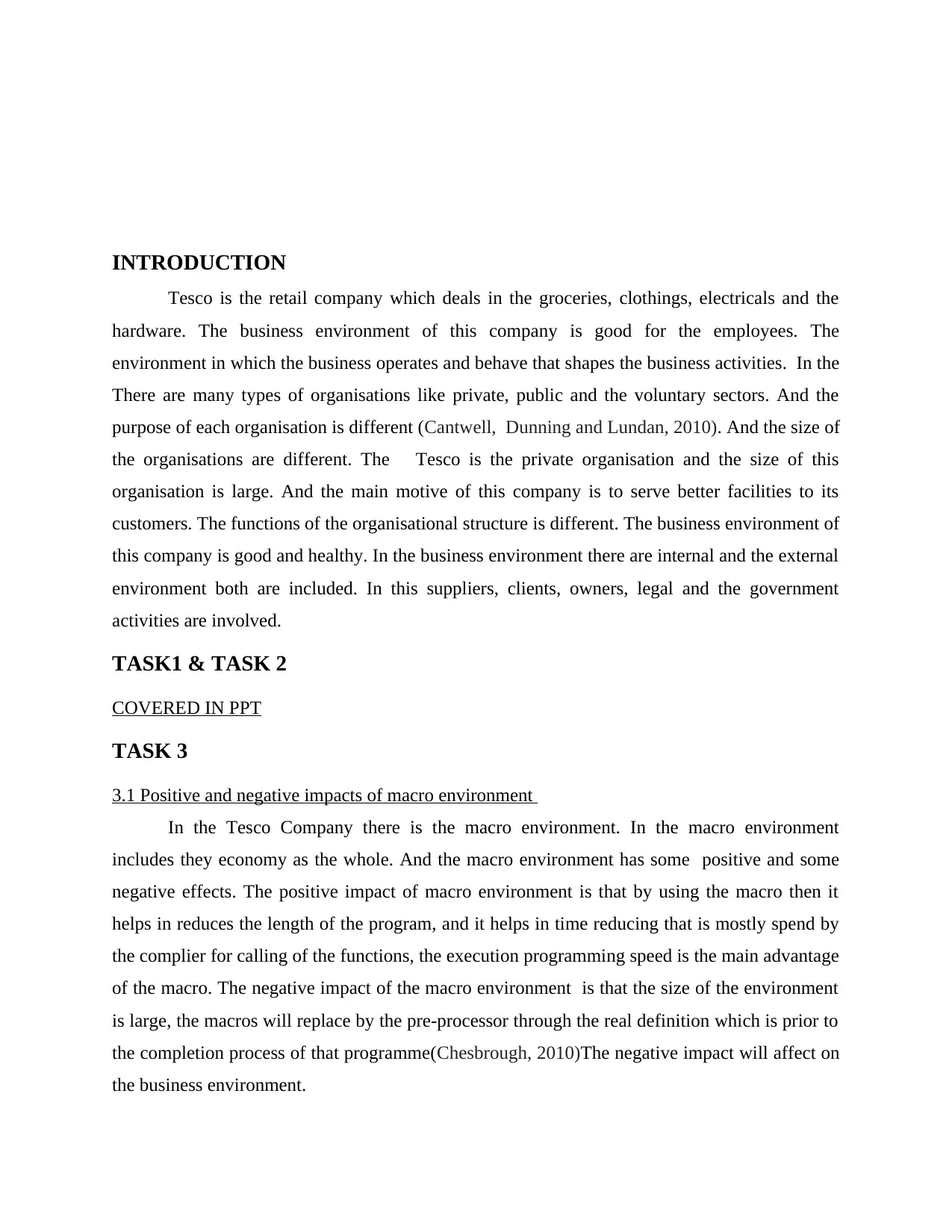
INTRODUCTION
Tesco is the retail company which deals in the groceries, clothings, electricals and the
hardware. The business environment of this company is good for the employees. The
environment in which the business operates and behave that shapes the business activities. In the
There are many types of organisations like private, public and the voluntary sectors. And the
purpose of each organisation is different (Cantwell, Dunning and Lundan, 2010). And the size of
the organisations are different. The Tesco is the private organisation and the size of this
organisation is large. And the main motive of this company is to serve better facilities to its
customers. The functions of the organisational structure is different. The business environment of
this company is good and healthy. In the business environment there are internal and the external
environment both are included. In this suppliers, clients, owners, legal and the government
activities are involved.
TASK1 & TASK 2
COVERED IN PPT
TASK 3
3.1 Positive and negative impacts of macro environment
In the Tesco Company there is the macro environment. In the macro environment
includes they economy as the whole. And the macro environment has some positive and some
negative effects. The positive impact of macro environment is that by using the macro then it
helps in reduces the length of the program, and it helps in time reducing that is mostly spend by
the complier for calling of the functions, the execution programming speed is the main advantage
of the macro. The negative impact of the macro environment is that the size of the environment
is large, the macros will replace by the pre-processor through the real definition which is prior to
the completion process of that programme(Chesbrough, 2010)The negative impact will affect on
the business environment.
Tesco is the retail company which deals in the groceries, clothings, electricals and the
hardware. The business environment of this company is good for the employees. The
environment in which the business operates and behave that shapes the business activities. In the
There are many types of organisations like private, public and the voluntary sectors. And the
purpose of each organisation is different (Cantwell, Dunning and Lundan, 2010). And the size of
the organisations are different. The Tesco is the private organisation and the size of this
organisation is large. And the main motive of this company is to serve better facilities to its
customers. The functions of the organisational structure is different. The business environment of
this company is good and healthy. In the business environment there are internal and the external
environment both are included. In this suppliers, clients, owners, legal and the government
activities are involved.
TASK1 & TASK 2
COVERED IN PPT
TASK 3
3.1 Positive and negative impacts of macro environment
In the Tesco Company there is the macro environment. In the macro environment
includes they economy as the whole. And the macro environment has some positive and some
negative effects. The positive impact of macro environment is that by using the macro then it
helps in reduces the length of the program, and it helps in time reducing that is mostly spend by
the complier for calling of the functions, the execution programming speed is the main advantage
of the macro. The negative impact of the macro environment is that the size of the environment
is large, the macros will replace by the pre-processor through the real definition which is prior to
the completion process of that programme(Chesbrough, 2010)The negative impact will affect on
the business environment.
⊘ This is a preview!⊘
Do you want full access?
Subscribe today to unlock all pages.

Trusted by 1+ million students worldwide
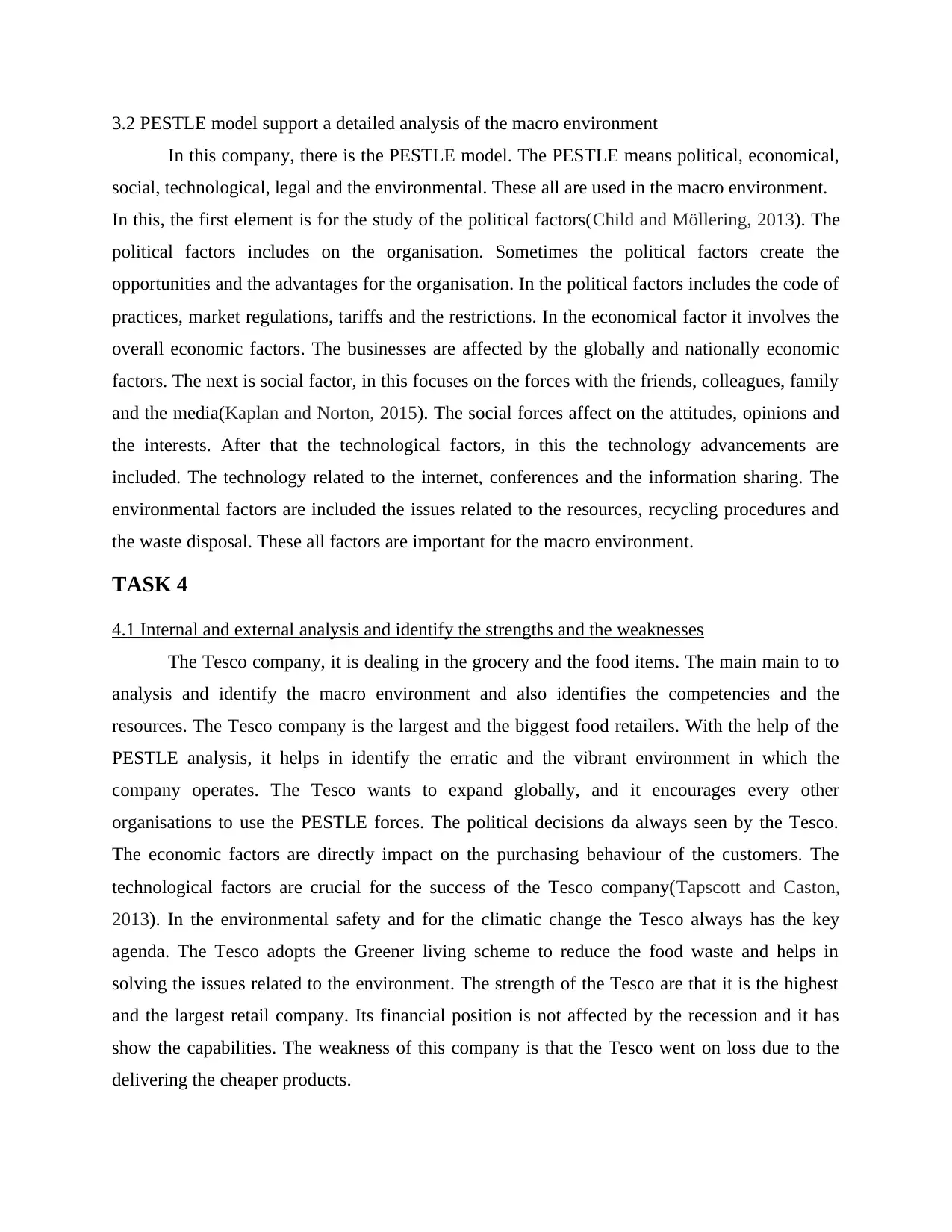
3.2 PESTLE model support a detailed analysis of the macro environment
In this company, there is the PESTLE model. The PESTLE means political, economical,
social, technological, legal and the environmental. These all are used in the macro environment.
In this, the first element is for the study of the political factors(Child and Möllering, 2013). The
political factors includes on the organisation. Sometimes the political factors create the
opportunities and the advantages for the organisation. In the political factors includes the code of
practices, market regulations, tariffs and the restrictions. In the economical factor it involves the
overall economic factors. The businesses are affected by the globally and nationally economic
factors. The next is social factor, in this focuses on the forces with the friends, colleagues, family
and the media(Kaplan and Norton, 2015). The social forces affect on the attitudes, opinions and
the interests. After that the technological factors, in this the technology advancements are
included. The technology related to the internet, conferences and the information sharing. The
environmental factors are included the issues related to the resources, recycling procedures and
the waste disposal. These all factors are important for the macro environment.
TASK 4
4.1 Internal and external analysis and identify the strengths and the weaknesses
The Tesco company, it is dealing in the grocery and the food items. The main main to to
analysis and identify the macro environment and also identifies the competencies and the
resources. The Tesco company is the largest and the biggest food retailers. With the help of the
PESTLE analysis, it helps in identify the erratic and the vibrant environment in which the
company operates. The Tesco wants to expand globally, and it encourages every other
organisations to use the PESTLE forces. The political decisions da always seen by the Tesco.
The economic factors are directly impact on the purchasing behaviour of the customers. The
technological factors are crucial for the success of the Tesco company(Tapscott and Caston,
2013). In the environmental safety and for the climatic change the Tesco always has the key
agenda. The Tesco adopts the Greener living scheme to reduce the food waste and helps in
solving the issues related to the environment. The strength of the Tesco are that it is the highest
and the largest retail company. Its financial position is not affected by the recession and it has
show the capabilities. The weakness of this company is that the Tesco went on loss due to the
delivering the cheaper products.
In this company, there is the PESTLE model. The PESTLE means political, economical,
social, technological, legal and the environmental. These all are used in the macro environment.
In this, the first element is for the study of the political factors(Child and Möllering, 2013). The
political factors includes on the organisation. Sometimes the political factors create the
opportunities and the advantages for the organisation. In the political factors includes the code of
practices, market regulations, tariffs and the restrictions. In the economical factor it involves the
overall economic factors. The businesses are affected by the globally and nationally economic
factors. The next is social factor, in this focuses on the forces with the friends, colleagues, family
and the media(Kaplan and Norton, 2015). The social forces affect on the attitudes, opinions and
the interests. After that the technological factors, in this the technology advancements are
included. The technology related to the internet, conferences and the information sharing. The
environmental factors are included the issues related to the resources, recycling procedures and
the waste disposal. These all factors are important for the macro environment.
TASK 4
4.1 Internal and external analysis and identify the strengths and the weaknesses
The Tesco company, it is dealing in the grocery and the food items. The main main to to
analysis and identify the macro environment and also identifies the competencies and the
resources. The Tesco company is the largest and the biggest food retailers. With the help of the
PESTLE analysis, it helps in identify the erratic and the vibrant environment in which the
company operates. The Tesco wants to expand globally, and it encourages every other
organisations to use the PESTLE forces. The political decisions da always seen by the Tesco.
The economic factors are directly impact on the purchasing behaviour of the customers. The
technological factors are crucial for the success of the Tesco company(Tapscott and Caston,
2013). In the environmental safety and for the climatic change the Tesco always has the key
agenda. The Tesco adopts the Greener living scheme to reduce the food waste and helps in
solving the issues related to the environment. The strength of the Tesco are that it is the highest
and the largest retail company. Its financial position is not affected by the recession and it has
show the capabilities. The weakness of this company is that the Tesco went on loss due to the
delivering the cheaper products.
Paraphrase This Document
Need a fresh take? Get an instant paraphrase of this document with our AI Paraphraser
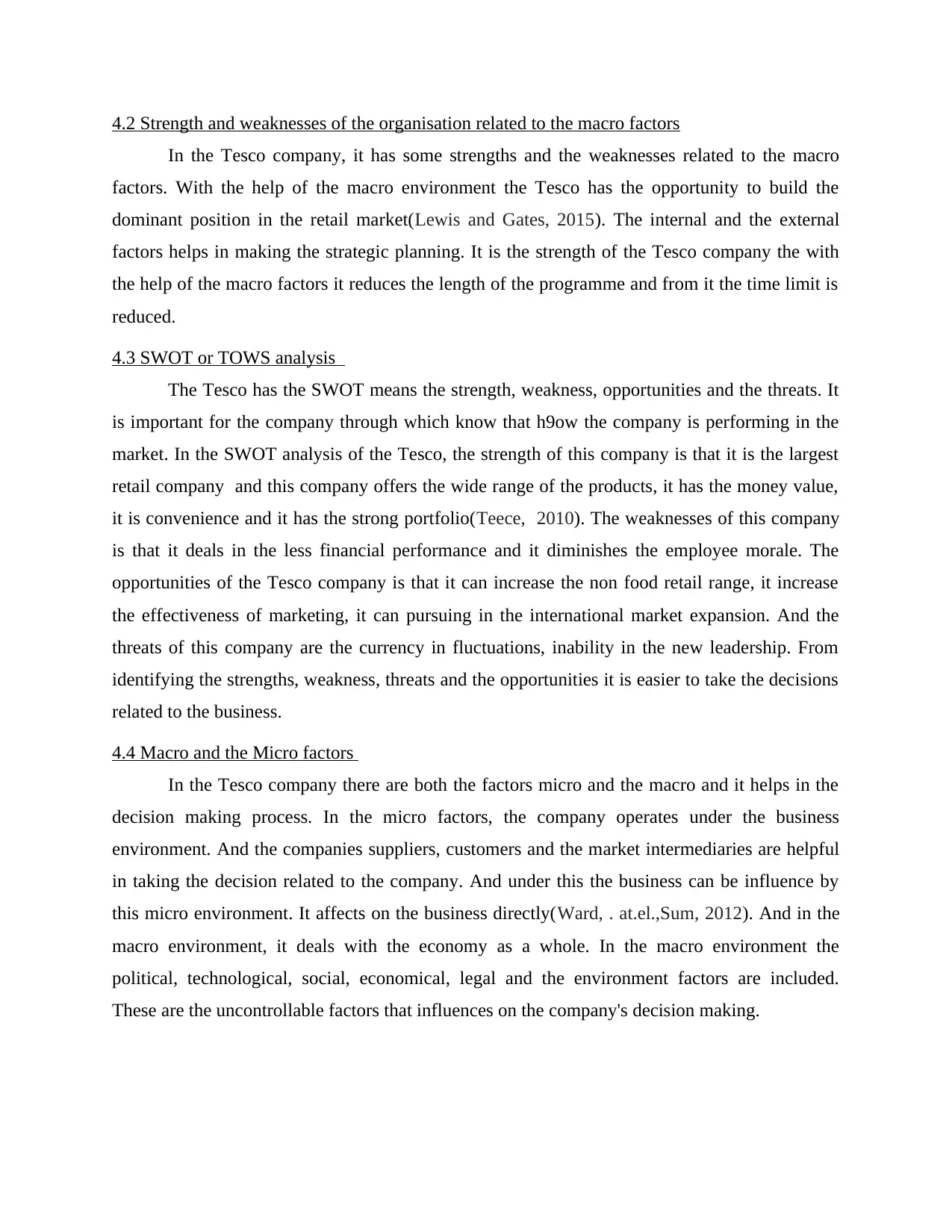
4.2 Strength and weaknesses of the organisation related to the macro factors
In the Tesco company, it has some strengths and the weaknesses related to the macro
factors. With the help of the macro environment the Tesco has the opportunity to build the
dominant position in the retail market(Lewis and Gates, 2015). The internal and the external
factors helps in making the strategic planning. It is the strength of the Tesco company the with
the help of the macro factors it reduces the length of the programme and from it the time limit is
reduced.
4.3 SWOT or TOWS analysis
The Tesco has the SWOT means the strength, weakness, opportunities and the threats. It
is important for the company through which know that h9ow the company is performing in the
market. In the SWOT analysis of the Tesco, the strength of this company is that it is the largest
retail company and this company offers the wide range of the products, it has the money value,
it is convenience and it has the strong portfolio(Teece, 2010). The weaknesses of this company
is that it deals in the less financial performance and it diminishes the employee morale. The
opportunities of the Tesco company is that it can increase the non food retail range, it increase
the effectiveness of marketing, it can pursuing in the international market expansion. And the
threats of this company are the currency in fluctuations, inability in the new leadership. From
identifying the strengths, weakness, threats and the opportunities it is easier to take the decisions
related to the business.
4.4 Macro and the Micro factors
In the Tesco company there are both the factors micro and the macro and it helps in the
decision making process. In the micro factors, the company operates under the business
environment. And the companies suppliers, customers and the market intermediaries are helpful
in taking the decision related to the company. And under this the business can be influence by
this micro environment. It affects on the business directly(Ward, . at.el.,Sum, 2012). And in the
macro environment, it deals with the economy as a whole. In the macro environment the
political, technological, social, economical, legal and the environment factors are included.
These are the uncontrollable factors that influences on the company's decision making.
In the Tesco company, it has some strengths and the weaknesses related to the macro
factors. With the help of the macro environment the Tesco has the opportunity to build the
dominant position in the retail market(Lewis and Gates, 2015). The internal and the external
factors helps in making the strategic planning. It is the strength of the Tesco company the with
the help of the macro factors it reduces the length of the programme and from it the time limit is
reduced.
4.3 SWOT or TOWS analysis
The Tesco has the SWOT means the strength, weakness, opportunities and the threats. It
is important for the company through which know that h9ow the company is performing in the
market. In the SWOT analysis of the Tesco, the strength of this company is that it is the largest
retail company and this company offers the wide range of the products, it has the money value,
it is convenience and it has the strong portfolio(Teece, 2010). The weaknesses of this company
is that it deals in the less financial performance and it diminishes the employee morale. The
opportunities of the Tesco company is that it can increase the non food retail range, it increase
the effectiveness of marketing, it can pursuing in the international market expansion. And the
threats of this company are the currency in fluctuations, inability in the new leadership. From
identifying the strengths, weakness, threats and the opportunities it is easier to take the decisions
related to the business.
4.4 Macro and the Micro factors
In the Tesco company there are both the factors micro and the macro and it helps in the
decision making process. In the micro factors, the company operates under the business
environment. And the companies suppliers, customers and the market intermediaries are helpful
in taking the decision related to the company. And under this the business can be influence by
this micro environment. It affects on the business directly(Ward, . at.el.,Sum, 2012). And in the
macro environment, it deals with the economy as a whole. In the macro environment the
political, technological, social, economical, legal and the environment factors are included.
These are the uncontrollable factors that influences on the company's decision making.
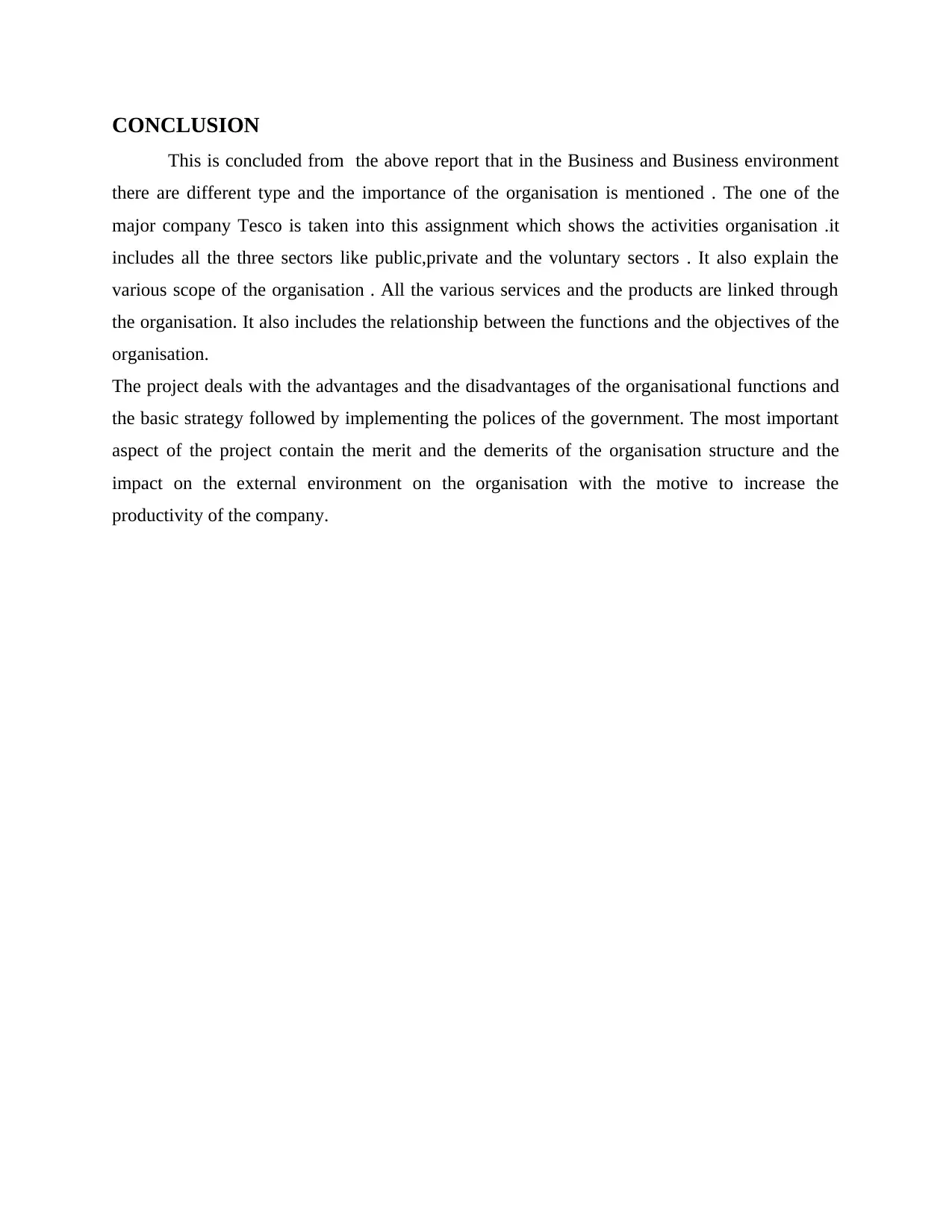
CONCLUSION
This is concluded from the above report that in the Business and Business environment
there are different type and the importance of the organisation is mentioned . The one of the
major company Tesco is taken into this assignment which shows the activities organisation .it
includes all the three sectors like public,private and the voluntary sectors . It also explain the
various scope of the organisation . All the various services and the products are linked through
the organisation. It also includes the relationship between the functions and the objectives of the
organisation.
The project deals with the advantages and the disadvantages of the organisational functions and
the basic strategy followed by implementing the polices of the government. The most important
aspect of the project contain the merit and the demerits of the organisation structure and the
impact on the external environment on the organisation with the motive to increase the
productivity of the company.
This is concluded from the above report that in the Business and Business environment
there are different type and the importance of the organisation is mentioned . The one of the
major company Tesco is taken into this assignment which shows the activities organisation .it
includes all the three sectors like public,private and the voluntary sectors . It also explain the
various scope of the organisation . All the various services and the products are linked through
the organisation. It also includes the relationship between the functions and the objectives of the
organisation.
The project deals with the advantages and the disadvantages of the organisational functions and
the basic strategy followed by implementing the polices of the government. The most important
aspect of the project contain the merit and the demerits of the organisation structure and the
impact on the external environment on the organisation with the motive to increase the
productivity of the company.
⊘ This is a preview!⊘
Do you want full access?
Subscribe today to unlock all pages.

Trusted by 1+ million students worldwide
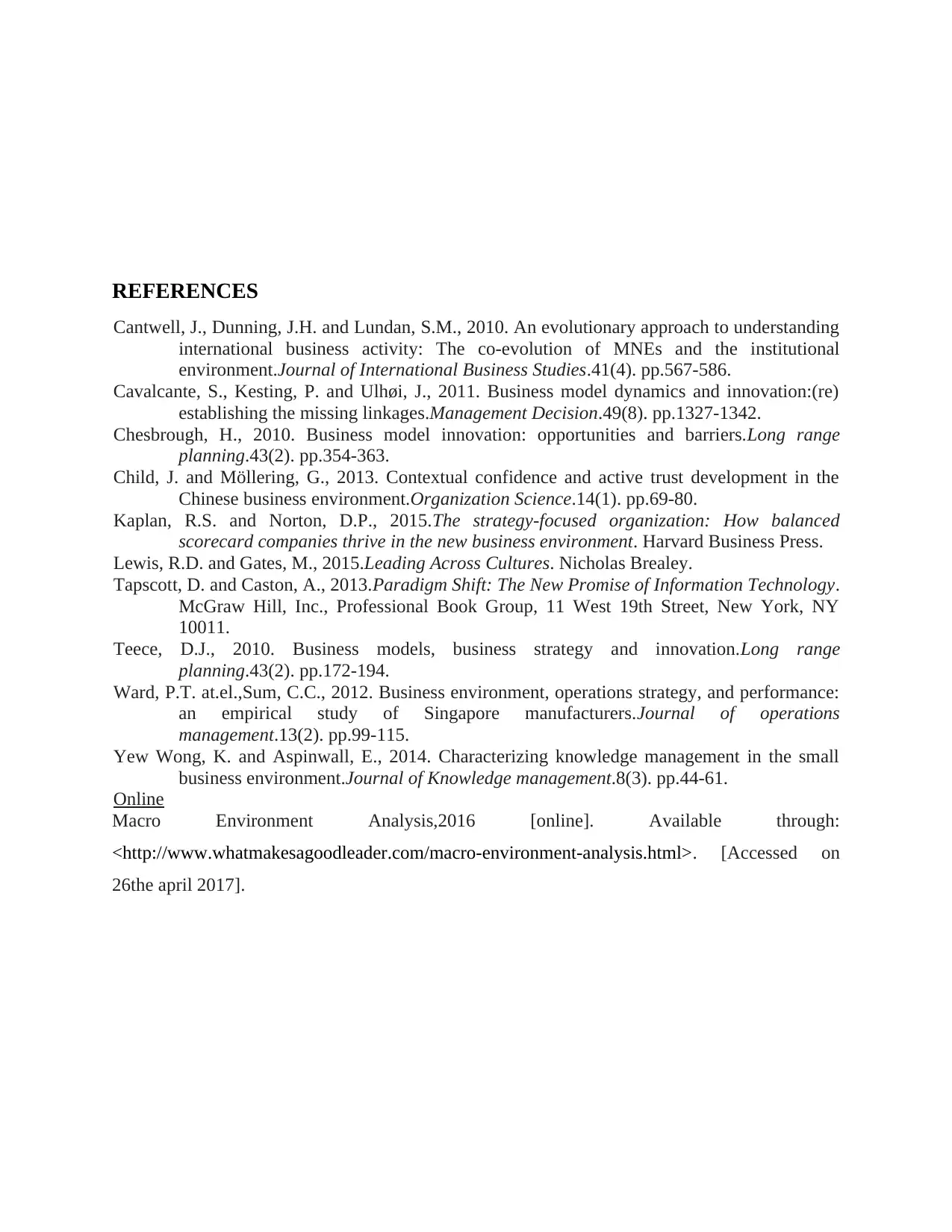
REFERENCES
Cantwell, J., Dunning, J.H. and Lundan, S.M., 2010. An evolutionary approach to understanding
international business activity: The co-evolution of MNEs and the institutional
environment.Journal of International Business Studies.41(4). pp.567-586.
Cavalcante, S., Kesting, P. and Ulhøi, J., 2011. Business model dynamics and innovation:(re)
establishing the missing linkages.Management Decision.49(8). pp.1327-1342.
Chesbrough, H., 2010. Business model innovation: opportunities and barriers.Long range
planning.43(2). pp.354-363.
Child, J. and Möllering, G., 2013. Contextual confidence and active trust development in the
Chinese business environment.Organization Science.14(1). pp.69-80.
Kaplan, R.S. and Norton, D.P., 2015.The strategy-focused organization: How balanced
scorecard companies thrive in the new business environment. Harvard Business Press.
Lewis, R.D. and Gates, M., 2015.Leading Across Cultures. Nicholas Brealey.
Tapscott, D. and Caston, A., 2013.Paradigm Shift: The New Promise of Information Technology.
McGraw Hill, Inc., Professional Book Group, 11 West 19th Street, New York, NY
10011.
Teece, D.J., 2010. Business models, business strategy and innovation.Long range
planning.43(2). pp.172-194.
Ward, P.T. at.el.,Sum, C.C., 2012. Business environment, operations strategy, and performance:
an empirical study of Singapore manufacturers.Journal of operations
management.13(2). pp.99-115.
Yew Wong, K. and Aspinwall, E., 2014. Characterizing knowledge management in the small
business environment.Journal of Knowledge management.8(3). pp.44-61.
Online
Macro Environment Analysis,2016 [online]. Available through:
<http://www.whatmakesagoodleader.com/macro-environment-analysis.html>. [Accessed on
26the april 2017].
Cantwell, J., Dunning, J.H. and Lundan, S.M., 2010. An evolutionary approach to understanding
international business activity: The co-evolution of MNEs and the institutional
environment.Journal of International Business Studies.41(4). pp.567-586.
Cavalcante, S., Kesting, P. and Ulhøi, J., 2011. Business model dynamics and innovation:(re)
establishing the missing linkages.Management Decision.49(8). pp.1327-1342.
Chesbrough, H., 2010. Business model innovation: opportunities and barriers.Long range
planning.43(2). pp.354-363.
Child, J. and Möllering, G., 2013. Contextual confidence and active trust development in the
Chinese business environment.Organization Science.14(1). pp.69-80.
Kaplan, R.S. and Norton, D.P., 2015.The strategy-focused organization: How balanced
scorecard companies thrive in the new business environment. Harvard Business Press.
Lewis, R.D. and Gates, M., 2015.Leading Across Cultures. Nicholas Brealey.
Tapscott, D. and Caston, A., 2013.Paradigm Shift: The New Promise of Information Technology.
McGraw Hill, Inc., Professional Book Group, 11 West 19th Street, New York, NY
10011.
Teece, D.J., 2010. Business models, business strategy and innovation.Long range
planning.43(2). pp.172-194.
Ward, P.T. at.el.,Sum, C.C., 2012. Business environment, operations strategy, and performance:
an empirical study of Singapore manufacturers.Journal of operations
management.13(2). pp.99-115.
Yew Wong, K. and Aspinwall, E., 2014. Characterizing knowledge management in the small
business environment.Journal of Knowledge management.8(3). pp.44-61.
Online
Macro Environment Analysis,2016 [online]. Available through:
<http://www.whatmakesagoodleader.com/macro-environment-analysis.html>. [Accessed on
26the april 2017].
1 out of 7
Related Documents
Your All-in-One AI-Powered Toolkit for Academic Success.
+13062052269
info@desklib.com
Available 24*7 on WhatsApp / Email
![[object Object]](/_next/static/media/star-bottom.7253800d.svg)
Unlock your academic potential
Copyright © 2020–2025 A2Z Services. All Rights Reserved. Developed and managed by ZUCOL.





